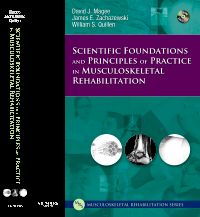Musculoskeletal Rehabilitation, Volume 2: Scientific Foundations and Principles of Practice provides a thorough review of the basic science information concerning the tissues of the musculoskeletal system impacted by injury or disease, as well as the guiding principles upon which rehabilitation interventions are based. This volume divides information into two sections: scientific foundations and principles of intervention, providing readers with a guiding set of clinical foundations and principles upon which they can easily develop treatment interventions for specific impairments and functional limitations.
Key Features
- Clinical application case studies help readers apply what they learn in the classroom to real life situations.
- Evidence-based content uses over 5,000 references to support the basic science information principles for rehabilitation interventions and provide the best evidence and physiological reasoning for treatment.
- Over 180 tables and 275 text boxes highlight key points within the text for better understanding.
- Expert editors David Magee, PhD, PT, James Zachazewski, DPT, SCS, ATC, Sandy Quillen, PT, PhD, SCS, FACSM and over 70 contributors provide authoritative guidance on the foundations and principles of musculoskeletal rehabilitation practice.
Author Information
By David J. Magee, BPT, PhD, CM, Professor
Department of Physical Therapy
Faculty of Rehabilitation Medicine
University of Alberta
Edmonton, Alberta, Canada; James E. Zachazewski, PT, DPT, SCS, ATC, Clinical Director
Department of Physical Therapy/Occupational Therapy
Massachusetts General Hospital
Boston, MA
Assistant Clinical Professor
Department of Physical Therapy
School of Health and Rehabilitation Sciences
MGH Institute of Health Professions
Charleston, MA and William S. Quillen, PT, PhD, SCS, FACSM, Associate Dean, College of Medicine
Professor and Director, School of Physical Therapy and Rehabilitation Sciences
University of South Florida
Tampa, FL, USA
SECTION I. SCIENTIFIC FOUNDATIONS
1. Injury, Inflammation, and Repair: Tissue Mechanics, the Healing Process, and Their Impact on the Musculoskeletal System
2. Ligament Injuries: Pathophysiology, Healing, and Treatment Considerations
3. Tendon Pathology and Injuries: Pathophysiology, Healing and Treatment Considerations
4. Adaptability of Skeletal Muscle: Response to Increased and Decreased Use
5. Skeletal Muscle: Deformation, Injury and Repair, and Treatment Considerations
6. Bone Biology and Mechanics
7. Cartilage of Human Joints and Related Structures
8. Peripheral Nerve: Structure, Function, and Physiology
9. Articular Neurophysiology and Sensorimotor Control
10. Pain: Perception and Mechanisms
11. Physiological Basis of Physical Agents
12. Pharmacology and Its Impact on the Rehabilitation Process
13. Effects of Aging-Growth Changes and Lifespan Concerns (0-40)
14. Effects of Aging: Growth Changes and Lifespan Concerns Ages 40+
SECTION II. PRINCIPLES OF PRACTICE
15. Rehabilitation Program Development: Clinical Decision Making, Prioritization, and Program Integration
16. Clinician’s Roles in Health Promotion, Wellness, and Physical Fitness
17. Physiological Principles of Conditioning for the Injured and Disabled
18. Principles of Neuromuscular Control for Injury Prevention and Rehabilitation
19. Principles of Stabilization and Training
20. Integration of the Cardiovascular System in Assessment and Interventions in Musculoskeletal Rehabilitation
21. Physiological Principles of Resistance Training And Functional Integration For The Injured and Disabled
22. Psychology of the Injured Patient
23. Integration of Stresses and their Relationship To The Kinetic Chain
24. Arthrokinematics and Mobilization of Musculoskeletal Tissue: The Principles
25. Range of Motion and Flexibility
26. The Utility of Orthopaedic Clinical Tests for Diagnosis
27. Imaging Joints and Musculoskeletal Tissue: Pathoanatomic Considerations
28. Fracture Management
29. Functional Testing and Return to Activity
"I have been practicing for 20 years and have never written to anyone I didn't know regarding a publication. However, I just wanted to thank you and congratulate you for your recent publication by Elsevier. I received the book on Friday and don't know which chapter to read next. It should be a mandatory text for physical therapy schools because of how it covers the fundamentals and basics. It is sometimes difficult to provide cutting edge material in books because of the publishing process, but you have done a great job. I plan on exposing the text to all students, physicians and health care professionals who cross my path. Since my last few years of practice have focused on pediatric sports medicine and childhood obesity, I will take the information and apply it accordingly to the growing and developing body. Thanks again for your wonderful contribution."
"I would recommend this book as essential for fellow physiotherapists who are either near the completion of their course or recently qualified, as well as people studying similar subjects.
I chose this book as a companion for the many textbooks I have which give the methodology of assessment techniques but do not cover the theory in depth. The text is easy to read yet still very comprehensive and summary boxes throughout the text provide the key points in a clear, concise way....The content covers everything you could want when working within the field of musculoskeletal rehabilitation. It includes a chapter on psychology, effects of aging, nerves and neurophysiology, pharmacology etc as well as the topics you would expect. It is not a quick reference textbook but if you need a through understanding of the background behind musculoskeletal rehab it is perfect."
Shula Baker, Physiotherapist, Mid Staffs NHS Foundation Trust














